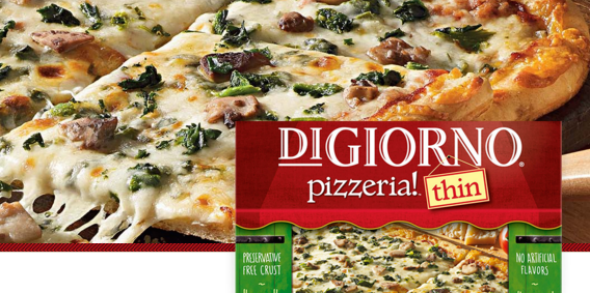We say we want our food purveyors to be transparent about their ingredients, but this is just going too far: Nestle USA has recalled more than 3 million frozen meals after customers reported finding tiny pieces of glass in their pizza and ravioli. The mass recall comes after consumers reported discovering glass particles in some DiGiorno, Lean Cuisine, and Stouffer’s meals earlier this week. Nestle recalled at least 12 types of meals.* (A full list of potentially affected meals appears at the bottom of this article.)
You are no doubt wondering: How did the glass get into the pizza? Nestle has traced the contamination back to a single source of spinach, which was present in all of the offending meals, said a company spokeswoman on Thursday. To be safe, Nestle recalled all of its spinach-containing products. But we still don’t know how the glass got into the spinach. The company is working with the USDA and the Food & Drug Administration to get to the bottom of this mystery, it said in a statement.
Remarkably, no injuries have yet been reported, according to the company.
You often hear stories of people getting more than they ordered with their meal, from a stranger’s tooth (!) in a Mars Bar to a mouse (!!) baked into a bread loaf to a human finger (!!!) in an Arby’s sandwich. This latest incident isn’t even the first time glass has been the unexpected special ingredient: Last year, baby-food–maker Beech-Nut had to recall more than 1,900 pounds of mushed sweet potato and chicken due to potential glass contamination. In 2010, Kaiser Permanente patients found glass fragments in their chicken-and-noodle soup.
In the latter case, the source wasn’t exactly difficult to trace. As the San Francisco Chronicle reported at the time:
The glass came from a container that broke while a cook was preparing soup at FoodService Partners’ South San Francisco commissary, said the company’s president, Bob Dunn. Rather than reporting the breakage and disposing of the soup, as company policy required, Dunn said, the cook simply tried to clean and flush the kettle before resuming preparations. In that instance, the only repercussions seem to be that the supersketchy cook was suspended and had to be “retrained.” Kaiser called the event a “very low-risk occurrence” and had its own gastrointestinal specialists conclude that there was little risk of harm because “the vast majority of any small foreign bodies ingested—even glass fragments—pass through the body within 2-3 days without complications.”
Funny, last time I checked, eating glass was definitely a no-no.
*Correction, March 14, 2016: This post originally misstated that there were reports of glass in at least 12 types of meals. The glass was found in “a few products,” according to Nestle.
